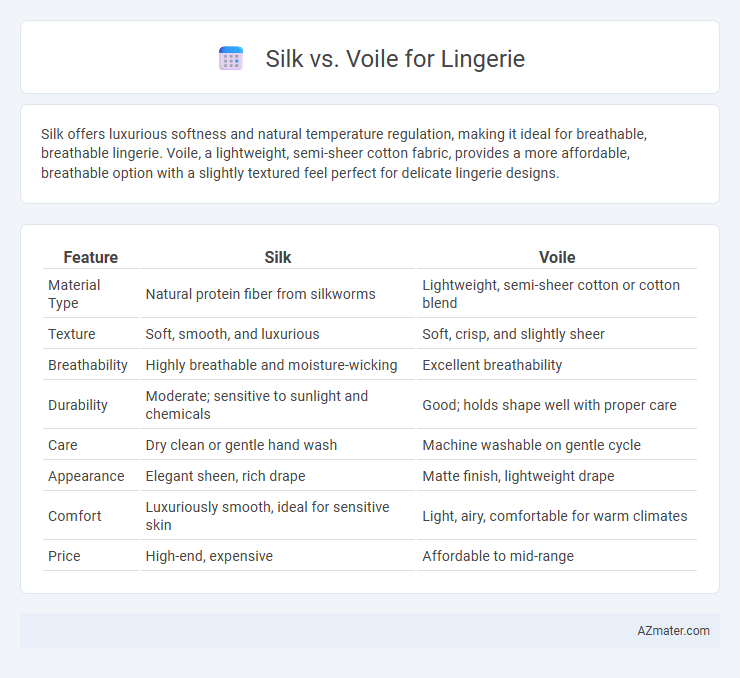Silk offers luxurious softness and natural temperature regulation, making it ideal for breathable, breathable lingerie. Voile, a lightweight, semi-sheer cotton fabric, provides a more affordable, breathable option with a slightly textured feel perfect for delicate lingerie designs.
Table of Comparison
| Feature | Silk | Voile |
|---|---|---|
| Material Type | Natural protein fiber from silkworms | Lightweight, semi-sheer cotton or cotton blend |
| Texture | Soft, smooth, and luxurious | Soft, crisp, and slightly sheer |
| Breathability | Highly breathable and moisture-wicking | Excellent breathability |
| Durability | Moderate; sensitive to sunlight and chemicals | Good; holds shape well with proper care |
| Care | Dry clean or gentle hand wash | Machine washable on gentle cycle |
| Appearance | Elegant sheen, rich drape | Matte finish, lightweight drape |
| Comfort | Luxuriously smooth, ideal for sensitive skin | Light, airy, comfortable for warm climates |
| Price | High-end, expensive | Affordable to mid-range |
Introduction to Silk and Voile Fabrics
Silk is a natural protein fiber known for its smooth texture, luxurious sheen, and excellent breathability, commonly used in high-end lingerie for its softness and moisture-wicking properties. Voile is a lightweight, semi-sheer cotton fabric characterized by a crisp feel and delicate drape, often preferred for breathable and airy lingerie designs. Both fabrics offer unique tactile experiences, with silk emphasizing softness and elegance, while voile provides a fresh, lightweight alternative suitable for warmer climates.
Key Differences Between Silk and Voile
Silk lingerie offers a luxurious, smooth texture with natural temperature regulation and high durability, making it ideal for intimate wear that feels soft against the skin. Voile lingerie, made from lightweight, semi-sheer cotton or cotton-blend fabric, provides breathability and a delicate, airy appearance but lacks the natural sheen and strength of silk. Key differences include silk's natural protein fiber composition versus voile's cotton-based weave, resulting in distinct care requirements, texture, and overall lingerie feel.
Texture and Feel: Silk vs Voile for Intimates
Silk offers a luxurious, smooth texture with a natural sheen that feels cool and soft against the skin, making it highly desirable for intimate apparel. Voile, a lightweight, semi-sheer cotton fabric, provides a breathable, slightly crisp texture that enhances comfort and airflow in lingerie. Choosing between silk and voile for intimates depends on the preference for either the rich, silky softness or the airy, matte finish of voile.
Breathability and Comfort in Lingerie
Silk offers natural breathability and moisture-wicking properties, making it ideal for lingerie that stays cool and comfortable against the skin. Voile, a lightweight cotton fabric, provides excellent air circulation and softness, enhancing comfort in warm conditions. Both fabrics excel in breathability, with silk offering a luxurious feel and voile delivering a crisp, breathable texture for everyday wear.
Durability and Longevity Comparison
Silk lingerie offers natural strength and resilience, maintaining its softness and sheen even after multiple washes, whereas voile, a lightweight cotton or polyester fabric, tends to show wear and tear more quickly under frequent use. Silk's protein fibers grant superior durability, resisting pilling and stretching better compared to voile's loosely woven structure which can snag or fade faster. Investing in silk lingerie ensures longer-lasting fabric integrity and luxurious feel, ideal for those prioritizing durability and longevity over affordability.
Aesthetic Appeal: Shine, Drape, and Transparency
Silk lingerie boasts a natural sheen that catches light beautifully, creating a luxurious and elegant appearance, while its smooth drape molds effortlessly to the body for a flattering silhouette. Voile, a lightweight cotton fabric, offers a subtle matte finish with a soft drape that flows gently, enhancing a delicate and airy aesthetic. The transparency of silk tends to be more lustrous and smooth, making it ideal for sensual designs, whereas voile's semi-sheer quality provides a modest, dreamy allure perfect for light, breathable lingerie.
Care and Maintenance Requirements
Silk lingerie requires gentle hand washing with cold water and mild detergent to preserve its delicate fibers, and it should be air-dried away from direct sunlight to prevent damage. Voile fabric, while lightweight and breathable, allows for machine washing on a gentle cycle but still benefits from using a mesh laundry bag to maintain its soft texture. Both materials demand careful handling to avoid stretching or snagging, ensuring longevity and maintaining the fabric's luxurious feel.
Skin Sensitivity and Hypoallergenic Qualities
Silk lingerie offers natural hypoallergenic properties, making it an excellent choice for sensitive skin due to its smooth texture and moisture-wicking abilities that reduce irritation and dryness. Voile, a lightweight cotton fabric, is breathable and less likely to cause allergic reactions, providing gentle comfort for those prone to skin sensitivities. Both fabrics promote skin health, but silk's protein structure closely mimics natural skin fibers, enhancing its appeal for hypoallergenic lingerie.
Price and Accessibility Considerations
Silk lingerie is often priced higher due to the labor-intensive production and the luxury reputation of mulberry silk fibers, making it less accessible for budget-conscious consumers. Voile, a lightweight cotton or polyester fabric, offers a more affordable alternative widely available in various retail outlets and online stores. The durability and easy maintenance of voile contribute to its practicality, whereas silk requires delicate care, influencing long-term accessibility and cost.
Choosing the Right Fabric: Silk or Voile for Your Lingerie
Silk offers luxurious softness and natural temperature regulation, making it ideal for lingerie that feels smooth against the skin and enhances comfort. Voile, a lightweight cotton fabric, provides breathability and a sheer, delicate appearance, perfect for those seeking a more breathable and affordable option. Selecting between silk and voile depends on preferences for texture, breathability, maintenance, and budget, with silk excelling in elegance and voile in lightweight comfort.

Infographic: Silk vs Voile for Lingerie
 azmater.com
azmater.com